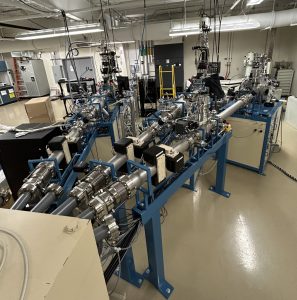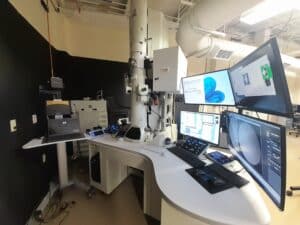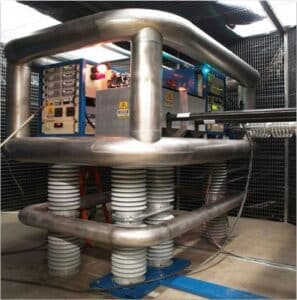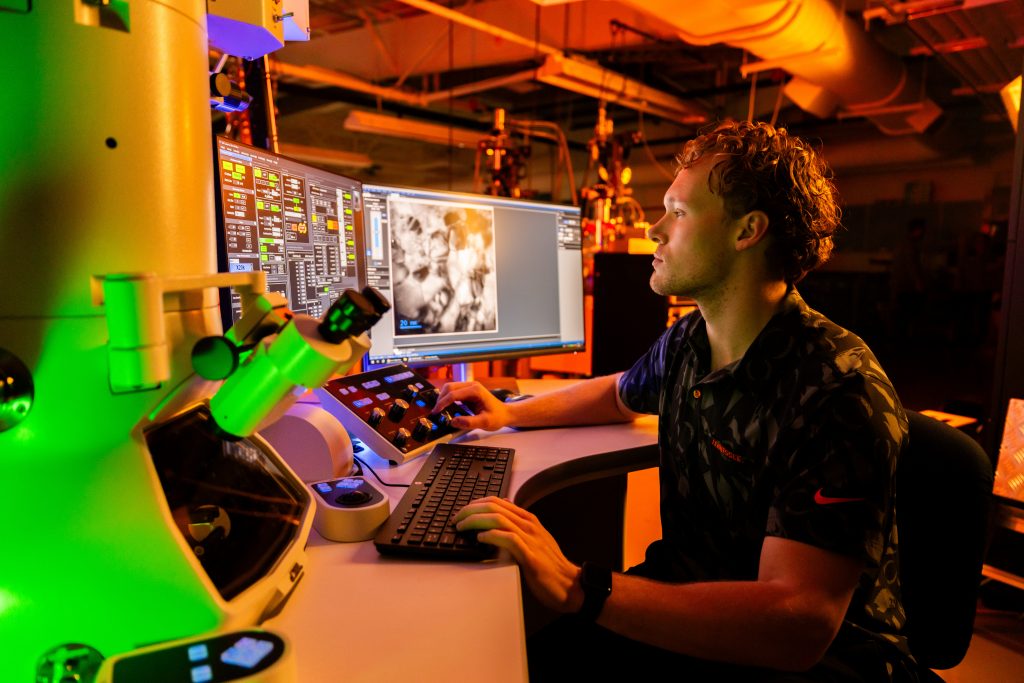The TIBML is equipped with a 3 MV tandem accelerator, two ion sources, four beamlines, and five endstations that provide state-of-the-art capabilities for ion beam analysis, materials modification, fundamental research on ion-solid interactions, and applied research on radiation effects in materials for nuclear and space applications.
Ion Beam Analysis
-
Rutherford backscattering spectrometry
-
non-Rutherford backscattering spectrometry
-
Rutherford backscattering spectrometry -channeling configuration
- Ion channeling
- Nuclear reaction analysis
-
Elastic recoil detection analysis
-
Time of flight elastic recoil detection analysis
 Ion Irradiation
Ion Irradiation
Ion implantation
- Ions of most elements, except rare gases, from hydrogen to gold
- Energies from 500 keV up to about 30 MeV, depending on ion and current needed
- Controlled irradiation temperatures from 30 to 1475 K
Nanoindenter
The Femtotools Nanoindenter makes real time in-situ mechanical testing during ion irradiation possible via CSM, Pillar compression, lock-key tensile and fatigue testing. With a force range 0.5 nN – 200 mN and a position sensing range from 50 pm to 21 mm, the nano indenter is capable of examining material properties such as creep and hardness during irradiation embrittlement under extreme conditions.
JEOL 2100+ TEM
 The JEM-2100 Plus is a multipurpose 200 kV LaB6 TEM that provides nanoscale characterization in extreme environments for a wide range of applications from materials science to medical/biological studies. The device functions at energies between 80 and 200 kV with a point resolution of 0.25 nm & a lattice resolution of 0.14 nm. High tilt stage permitting up to ±81° for a range of tomographic techniques. The equipped Gatan Clearview camera can capture 50 frames per second at 4k resolution allowing for high speed in-situ experiments.
The JEM-2100 Plus is a multipurpose 200 kV LaB6 TEM that provides nanoscale characterization in extreme environments for a wide range of applications from materials science to medical/biological studies. The device functions at energies between 80 and 200 kV with a point resolution of 0.25 nm & a lattice resolution of 0.14 nm. High tilt stage permitting up to ±81° for a range of tomographic techniques. The equipped Gatan Clearview camera can capture 50 frames per second at 4k resolution allowing for high speed in-situ experiments.
Other TEM Capabilities
- ASTAR Automatic TEM phase-orientation mapping to determine relative orientation of crystalline grains and grain boundaries.
- In-situ laser heating system with an adjustable spot size between ~75µm to 400µm and a tunable power output 0.5 to 5 watts allowing us to introduce rapid thermal heating with any TEM stage.
- Vision Bruker/Hysitron PI-95 is capable of preforming In-situ TEM indentation, pillar compression, lock-key tensile, fatigue, and creep analysis.

- Poseidon AX In-Situ Liquid Cell allows for the high-resolution observation of
 electro chemical reactions like the oxygen evolution reaction (OER) and hydrogen evolution reaction (HER).
electro chemical reactions like the oxygen evolution reaction (OER) and hydrogen evolution reaction (HER).
Future Capabilities
The TIMBL is growing rapidly with the addition of a TEM in 2024 and, in 2025, the addition of a 300 keV implanter and two low-energy ion sources, closing the gap and allowing us to cover a wider range of energies.
NEC Ion Implanter
NEC Ion Implanter with a 20 – 300 kV energy range with will complete the TIBML’s energy range and permit an even wider range of diverse applications. Some of the highlights of the new system include:
- Vacuum base pressure without beam of 5 x 10-8 Torr
- Mass to charge ratio greater than or equal to 200
- Large variety of ions ranging from H – Bi can be produced
- All-metal and ceramic accelerator tube, bakeable to 500°
- Electrostatic quadrupole triplet lens can control beam spot size from 6 mm at 20 keV – 2 cm at 10 keV

Quanta-Ray Nd:YAG Laser
 A recently added Quanta-Ray Nd:YAG Laser (1600mJ @ 30Hz), capable of powers in excess of ~48 Watts, enables rapid heating of specific sample areas. When focused, the Quanta-ray laser is capable of heating areas of metals such as tungsten to its melting point, enabling studies under some of the most extreme conditions.
A recently added Quanta-Ray Nd:YAG Laser (1600mJ @ 30Hz), capable of powers in excess of ~48 Watts, enables rapid heating of specific sample areas. When focused, the Quanta-ray laser is capable of heating areas of metals such as tungsten to its melting point, enabling studies under some of the most extreme conditions.
AE and TGS Capabilities
Acoustic Emission (AE) will allow TIBML researchers to analyze the frequency, magnitude, and waveform of materials during Ion irradiation induced failure.Transient Grating Spectroscopy (TGS) will be used to gaining insight into a material’s elastic constant and thermal properties through surface acoustic wave. TGS has the unique ability to allow for rapid collection during non-contact and non-destructive measurement periods. It also can function at extremely high or cryogenic temperatures as the characterization is all done through a coated window.

Nonsequitur Ion Guns
5 kV Nonsequitur Ion Gun which features a focusing column optimized for low energy throughput, high brightness electron impact source for max bulk material removal and operates over range of inert gases.

20 kV Nonsequitur Ion Gun which features an adjustable spot size ≥ 5 µm for spatially defined sputtering or implantation from easily evaporated materials such as Cs, Li, Na, K, etc. as well as a dual octupole for beam scanning and astigmatism correction.

The Nonsequitur Ion Guns will push TIBML to be not only be an outstanding medium energy facility, but also a strong low and coupled range facility. Coupled with the Tandem they will provide dual and even triple beam irradiation of either bulk or TEM samples
